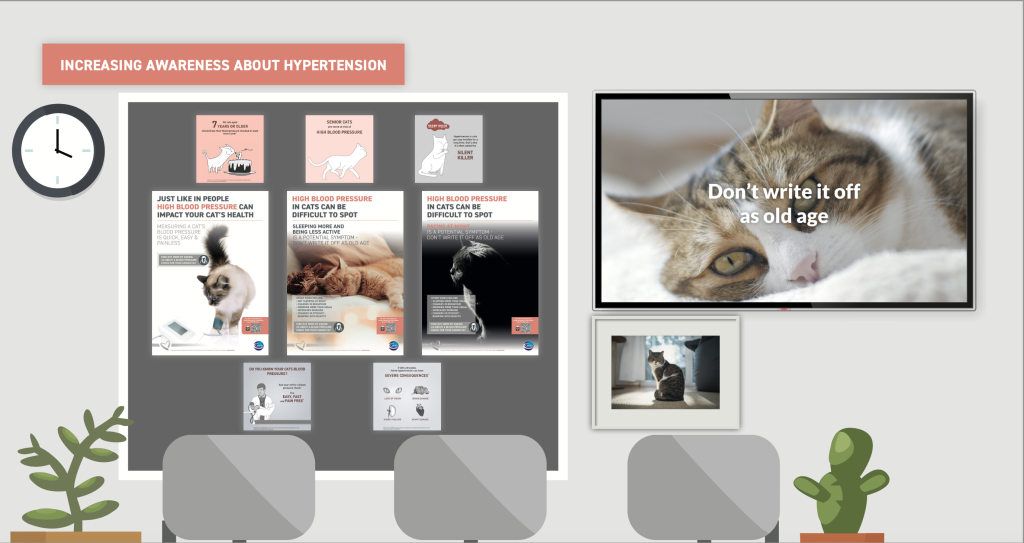
‘Make The Invisible, Visible’ In Cats With A Blood Pressure Check!
May is Feline Hypertension Awareness Month and vet practices around the UK are being urged to ‘make the invisible, visible’ by carrying out routine blood pressure checks in cats aged seven years or over1 to help identify feline hypertension.
Affecting approximately one in five cats nine years or over2, feline hypertension is known as the ‘silent killer’, as there are often no obvious signs. Furthermore, early signs of hypertension can be subtle and are often misinterpreted by owners as ‘old age’, leading to the condition being underdiagnosed. Unfortunately, when more marked clinical signs occur, it is often too late and the eyes, kidneys, heart and brain can be severely affected.
Initially, ISFM1 (International Society of Feline Medicine) advises that blood pressure should be checked annually in cats aged seven years or over, but as they get older they should have their blood pressure checked every six months and this is particularly important if cats have underlying health conditions such as chronic kidney disease (CKD) or hyperthyroidism.
Ceva Animal Health has launched a new feline hypertension toolkit packed full of resources to support veterinary practices wanting to talk to their clients about feline hypertension to help owners understand the importance of regular blood pressure measurements for their cats. The toolkit, which is available to download from https://easethepressure.co.uk/feline-hypertension-awareness-month/, will help veterinary professionals advise and educate their clients on feline hypertension.
The pack contains:
- Posters, leaflets and stickers to use in practice
- Waiting room display materials
- Ready to use social media posts and email content
- A communications guide to help support practices
Vet influencer ‘Louise the Vet’ will be supporting the campaign by spreading the word about feline hypertension and the importance of routine blood pressure checks in cats on her social media channels.
During Feline Hypertension Awareness Month, Ceva is encouraging vet professionals to ‘think outside the box’ to creatively ‘make the invisible, visible’ and encourage conversations about hypertension with clients. A waiting room display competition will be held to reward creativity, with a prize of a doppler machine for the winning vet practice.
Suzanne Page, Amodip® product manager at Ceva Animal Health, comments: “Feline hypertension is extremely common and an early diagnosis is crucial to help prevent serious damage. By monitoring cats aged seven or over with routine blood pressure tests, there is a real opportunity to improve the health and welfare of our older feline population as, once diagnosed, hypertension can easily and efficiently be treated with the daily administration of an appropriate treatment. Our new feline hypertension resources will help veterinary professionals advise and educate their clients on feline hypertension and provide valuable information to help keep their cats healthy and happy for longer.”
To download a feline hypertension toolkit or for information on feline hypertension or Amodip, visit https://easethepressure.co.uk/feline-hypertension-awareness-month/. For further information on Amodip, please contact your local Ceva Animal Health account manager or email [email protected].
References
- Taylor SS, Sparkes AH, et al. ISFM Consensus Guidelines on the Diagnosis and Management of Hypertension in Cats. J Feline Med Surg. 2017.19(3):288-303
- Conroy M, Chang YM, Brodbelt D, Elliott J. Survival after diagnosis of hypertension in cats attending primary care practice in the United Kingdom. J Vet Intern Med. 2018 Nov;32(6): 1846-1855
More from Ceva
- Collaborative effort to strengthen Singapore’s preparedness against avian influenza
- Ease Pet Anxiety This Fireworks Season with Ceva's Vet-Approved Solutions
- Ceva and International Cat Care launch season 2 of cat handling training videos
- Ceva launches service to highlight the cost of infertility linked to Q fever
- Are vets and farmers under-using pain relief in dairy cows?

 3 years ago
3 years ago  1193 views
1193 views